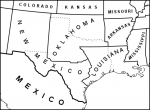Ricardolindo
Well-known member
- Location
- Portugal
The US could have had Texas up to the Colorado River in the Adam-Onis Treaty in 1819. What are the effects of this? I think this could have, actually, hurt the US in the long run. In our timeline, almost all American settlers in Tejas were east of the Colorado. Thus, the Texas Revolution almost certainly wouldn't happen. Could this timeline end up with Mexico keeping Southern California, Arizona, New Mexico and rump Tejas?
Last edited:


